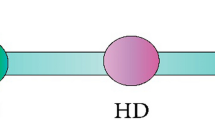Core Message
Description of phenotypic characteristics leading to suspicion of Laron syndrome and means of its diagnosis
Access provided by Autonomous University of Puebla. Download chapter PDF
Similar content being viewed by others
Keywords
These keywords were added by machine and not by the authors. This process is experimental and the keywords may be updated as the learning algorithm improves.
The diagnosis of Laron syndrome should be suspected in infants, older children, or adults who present with a height deficit of −4 to −10 height SDS and with the typical features (shown in Figs 1.1 and 1.2 in Chap. 1) (facial phenotype, dwarfism, obesity, hypogenitalism) identical with those of congenital isolated growth hormone (GH) deficiency (cIGHD), but by laboratory screening, having elevated serum hGH concentration in young age reaching acromegalic levels (see Chap. 2, Fig. 2.3) in the presence of very low or undetectable serum IGF-I. As in neonates and especially premature babies, blood hGH levels are high; determination of serum hGH at this age is useful only for determining the hGH deficiency (Laron et al. 2007).
Evidence for hGH insensitivity (resistance) is obtained by performing an IGF-I generation (stimulation test), i.e., administration of hGH 33 µg/kg s.c. for 4 or preferably 7 days, and determining serum IGF-I before, on day 5 and day 8 (i.e., the morning after the last injection). Lack of rise of the serum IGF-I is diagnostic for Laron syndrome (Fig 4.1) (Daughaday et al. 1969; Laron et al. 1971). The definite diagnosis is the documentation of a molecular defect in the hGH receptor (hGH-R) gene.
IGF-I stimulation (generation) test in patients with Laron syndrome compared to patients with IGHD (congenital hGH gene deletion). Note: Lack of rise of very low serum IGF-I during exogenous daily hGH administration in patients with Laron syndrome in contradistinction to the marked rise in the IGHD patients. Modified from Laron et al. (1971)
The location of the molecular genetic defect in the hGH receptor (Shevah et al. 2004a; Shevah et al. 2004b; Shevah and Laron 2006) gene requires preparation of DNA, PCR and sequencing (see Chap. 5 page 33). Lack of serum GHBP (growth hormone-binding protein), a rarely performed determination, discloses that the defect is in the extracellular domain of the GH-R (see pages 31–46). Exception to this seems to be patients with GH receptor mutations in intron 6 and the activation of a pseudo exon resulting in normal GHBP levels (David et al. 2007) in whom GHBP is positive. Mutations in the transmembrane or intracellular domains of the GH-R permitting GH binding to its receptor result in normal or high serum GHBP concentrations (Silbergeld et al. 1997). Low serum levels of IGFBP-3 (Laron et al. 1992a) and/or low IGF-I levels are not diagnostic (Laron et al. 1992b; Laron et al. 2007).
Table 4.1 summarizes the clinical and main laboratory features of untreated Laron Syndrome as compared to congenital isolated GH deficiency (IGHD). It is seen that the only diagnostic distinctions are the high serum hGH levels and lack of rise of IGF-I upon hGH administration. The final proof is obtained by genetic analysis of the hGH receptor gene.
References
Daughaday WH, Laron Z, Pertzelan A, Heins JN (1969) Defective sulfation factor generation: a possible etiological link in dwarfism. Trans Assoc Am Physicians lxxxii:129–138
David A, Camacho-Hübner C, Bhangoo A, Rose SJ, Miraki-Moud F, Akker SA, Butler GE, Ten S, Clayton PE, Clark AJ, Savage MO, Metherell LA (2007) An intronic growth hormone receptor mutation causing activation of a pseudoexon is associated with a broad spectrum of growth hormone insensitivity phenotypes. J Clin Endocrinol Metab 92:655–659
Laron Z, Pertzelan A, Karp M, Kowadlo-Silbergeld A, Daughaday WH (1971) Administration of growth hormone to patients with familial dwarfism with high plasma immunoreactive growth hormone. Measurement of sulfation factor, metabolic, and linear growth responses. J Clin Endocrinol Metab 33:332–342
Laron Z, Klinger B, Blum WF, Silbergeld A, Ranke MB (1992a) IGF binding protein 3 in patients with LTD: effect of exogenous rIGF-I. Clin Endocrinol 36:301–304
Laron Z, Suikkari AM, Klinger B, Silbergeld A, Pertzelan A, Seppala M, Koivisto VA (1992b) Growth hormone and insulin-like growth factor regulate insulin-like growth factor binding protein in Laron type dwarfism, growth hormone deficiency and constitutional growth retardation. Acta Endocrinol 127:351–358
Laron Z, Bidlingmaier M, Strasburger CJ (2007) Indications, limitations and pitfalls in the determination of human growth hormone, IGF-I and their binding proteins. Pediatr Endocrinol Rev 5(suppl):555–569
Shevah O, Laron Z (2006) Genetic analysis of the pedigrees and molecular defects of the GH-receptor gene in the Israeli cohort of patients with Laron syndrome. Pediatr Endocrinol Rev 3(suppl 3):489–497
Shevah O, Rubinstein M, Laron Z (2004a) Molecular defects of the growth hormone receptor gene, including a new mutation, in Laron Syndrome patients in Israel: relationship between defects and ethnic groups. Isr Med Assoc J 6:630–633
Shevah O, Galli-Tsinopoulou A, Rubinstein M, Nousia-Arvanitakis S, Laron Z (2004b) Classical phenotype of Laron syndrome in a girl with a heterozygous mutation and heterozygous polymorphism of the growth hormone receptor gene. J Pediat Endocrinol Metab 17:371–374
Silbergeld A, Dastot F, Klinger B, Kanety H, Eshet R, Amselem S, Laron Z (1997) Intronic mutation in the growth hormone (GH) receptor gene from a girl with Laron syndrome and extremely high serum GH binding protein: extended phenotypic study in a very large pedigree. J Pediatr Endocrinol Metab 10:265–274
Author information
Authors and Affiliations
Corresponding author
Editor information
Editors and Affiliations
Rights and permissions
Copyright information
© 2011 Springer Berlin Heidelberg
About this chapter
Cite this chapter
Laron, Z. (2011). Diagnosis of Laron Syndrome. In: Laron, Z., Kopchick, J. (eds) Laron Syndrome - From Man to Mouse. Springer, Berlin, Heidelberg. https://doi.org/10.1007/978-3-642-11183-9_4
Download citation
DOI: https://doi.org/10.1007/978-3-642-11183-9_4
Published:
Publisher Name: Springer, Berlin, Heidelberg
Print ISBN: 978-3-642-11182-2
Online ISBN: 978-3-642-11183-9
eBook Packages: MedicineMedicine (R0)





